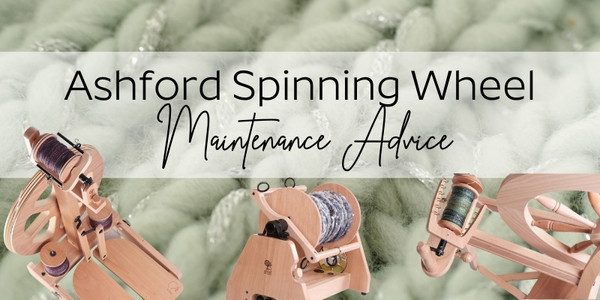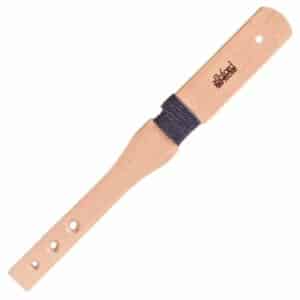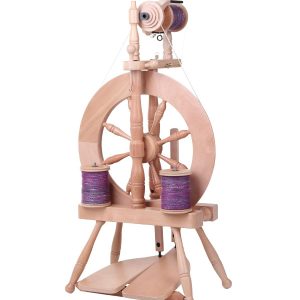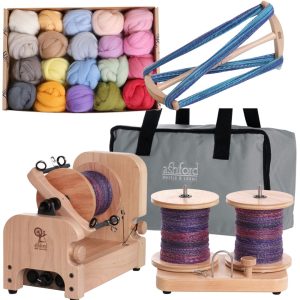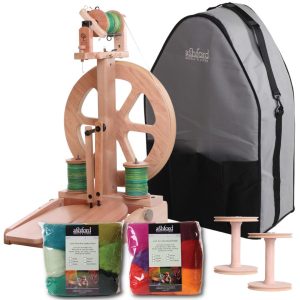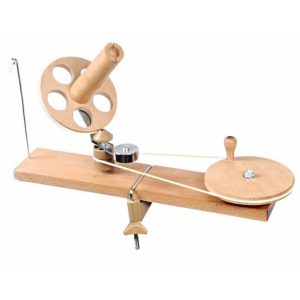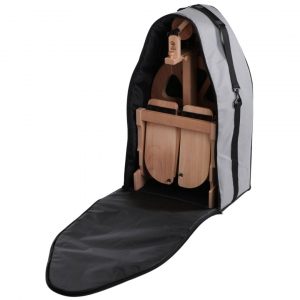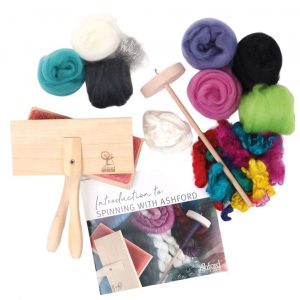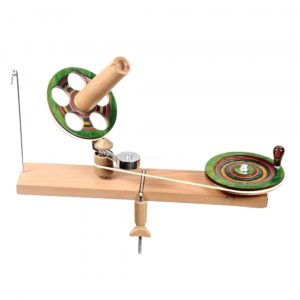If you find yourself looking for Ashford Spinning Wheel Advice, Richard Ashford has put together some great information below. It will keeping your spinning wheels in tip top shape. In this article you will find information on both current and previous model spinning wheels. Ashford and myself at The Good Yarn are sure you will find this article helpful as you learn to look after your Ashford spinning wheel.
The following information is courtesy of Ashford
The following spinning wheels are covered:
- All Ashford Spinning Wheels
- Ashford e-spinners
- Ashford traditionals
- Ashford traveller
- Ashford elizabeth
- Ashford joy
- Ashford kiwi
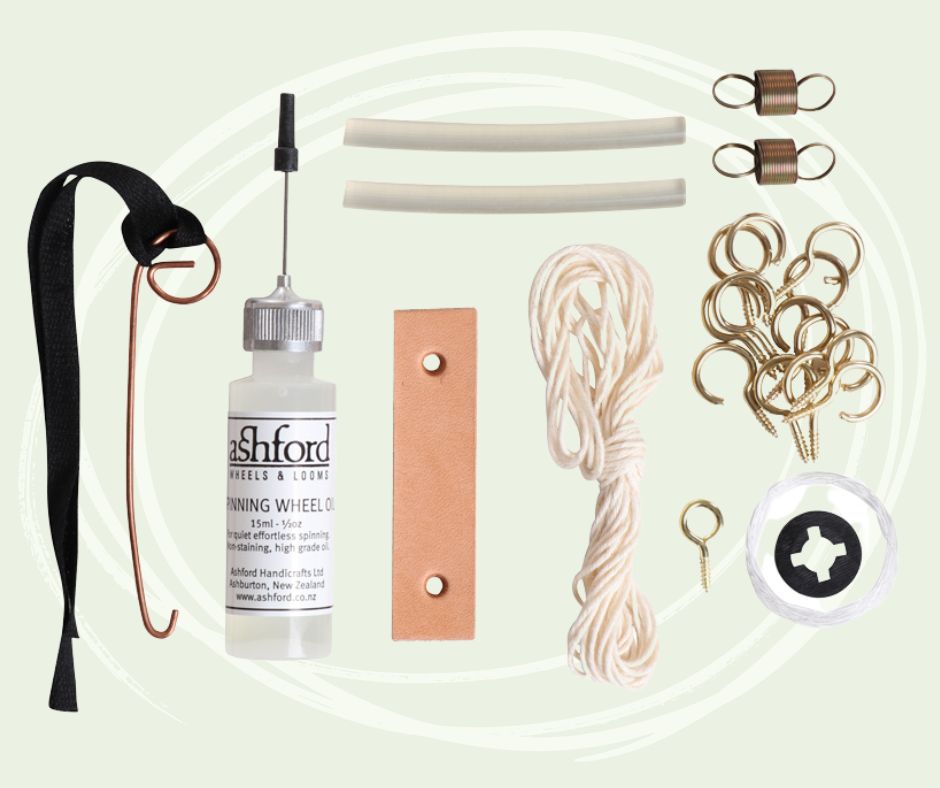
For your pleasure and enjoyment when spinning, the most important aspect of spinning wheel maintenance is to ensure the 3 main elements of the spinning wheel are free to rotate. Please use the following check list to ensure your wheel is smooth and easy to treadle.
Start by removing the drive and brake bands. Use Ashford Spinning Wheel oil on all nylon bearings. Wipe off any surplus oil. Since 2008 the wheels on all Ashford spinning wheels are mounted on ball bearings which are sealed for life and do not need any lubrication.
The Ashford Maintenance Kit includes a bottle of oil and most of the parts you will need to return your wheel to its original condition.
All Ashford spinning wheels maintenance
Current Ashford Spinning Wheels
- Spin the wheel. It should rotate freely for up 100 turns on ball bearings or 20 on nylon bearings. If it not:
- Remove any fibre that has accumulated on the crank or in the bearings with tweezers.
- Apply a drop of oil to the nylon con rod joint regularly.
- Rub candle wax or apply a drop of oil to the treadle rail pins to reduce noise or friction.
- If the moulded con rod joint squeaks, remove it from the treadle board and rub bees wax onto the section that fits in the wood.
- If the drive band is worn or the knot is lumpy, replace it with a new soft cotton drive band or Turbo Kit.
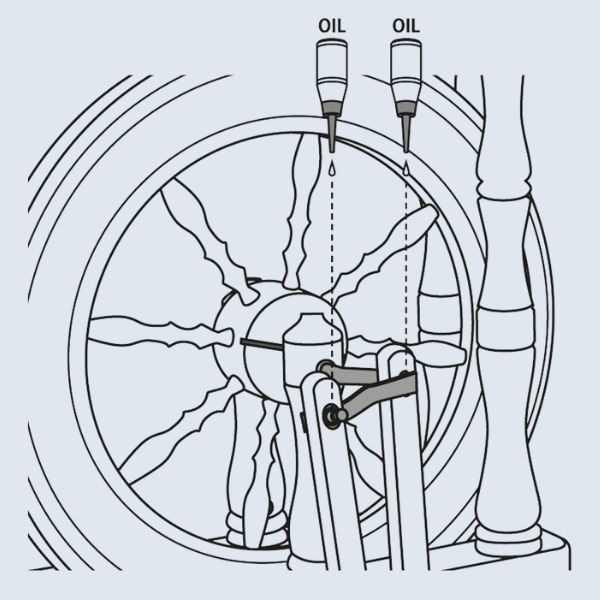
Early Ashford Spinning Wheels
- Apply a drop of oil to the nylon wheel bearings regularly.
- If your wheel is a double treadle wheel made before 2012, lay it on its back and apply a drop of oil to each hinge pins. Since then, Ashford have used moulded hinges which do not need lubrication.
- If your wheel has a leather con rod joint that has become soft or floppy, replace it with a new leather joint.
- If you wheel has a round polyurethane con rod joint, check that the gap between the bottom of the con rod (pitman) and the treadle rail is between 12 – 18mm (1/2 – 3/4″). If greater than this, it can cause ankle strain and if closer the two can bind thus stretching the joint. If necessary, replace the joint and cut off any surplus underneath. The black moulded con rod joints were introduced in 2012.
Flyer
- Spin the flyer. It should rotate freely. If not:
- Check there is at least 1-3mm (1/16”) end-float between the flyer, bobbin, and flyer bearings.
- Check the flyer bearings are at right angles to the flyer shaft. If not, loosen the screws holding the maid uprights to the maiden bar, align the bearings and retighten the screws.
- Apply a drop of oil to the flyer and bobbin bearings.
- If the spinning wheel is hard to treadle reduce the tension on the brake band. Ideally the springs should just start to stretch but never more than their own length.
- All Ashford spinning wheels now have 2 tension springs attached to the brake band either side of the bobbin whorl. These allow the brake band to work freely when both spinning and plying. If your wheel only has 1 tension spring, add a second tension spring on the opposite side.
- Check and remove any lanoline that may have built up in the flyer orifice.
When the yarn wont feed onto the bobbin
- If the yarn wont feed onto the bobbin, check for metal burrs on the inside of the flyer orifice exit hole. If necessary, remove with a file or sandpaper.
- If the yarn wont feed onto the bobbin, check in case the yarn is snagged or looped around a flyer hook or yarn guide.
- If the flyer hooks are worn or rough, replace them.
- When the nylon ring in a squeeze and slide yarn guide has a groove worn in it, simply rotate the ring until the yarn runs on a new smooth section.
- If the yarn guide doesn’t slide easily on the flyer arm, remove the yarn guide and rub a thin film of Ashford Finishing Wax onto the black fiberglass arms and rub it off with a soft cloth. Reinstall the yarn guide.
- If the wheel has been finished with polyurethane, lacquer or wax, check there isn’t any surplus material on the spindle, flyer or bobbin bearings that may be causing friction. If necessary, scrape this off with a craft knife or file.
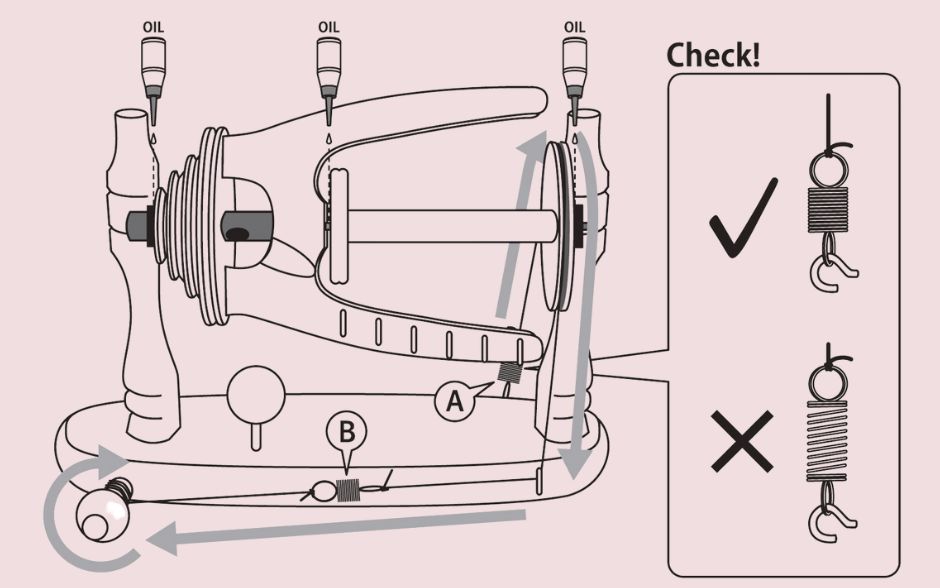
Bobbins
- Spin the bobbin on the flyer shaft. It should rotate freely. If not:
- Apply a drop of oil to the bobbin bearings.
- Check there is at least 1-3mm (1/16”) end float between the flyer, bobbin, and flyer bearings.
- If the bobbin is still tight on the flyer shaft, ream the bearings with a 1/4” (6.25mm) round fine chain saw file or fine sandpaper wrapped around a pencil.
Early bobbins
- Bobbins made prior to 1980 didn’t have nylon bearings. When the bobbin centre has warped or the hole is worn, then it is time to replace it with a new bobbin.
- If a new bobbin has been fitted to a very old flyer and the small bobbin end rubs against the flyer, use a wood file or sandpaper or to remove wood where the bobbin touches the flyer.
- If the bobbin ends are loose, re-glue them with a reliable wood glue.
Double Drive Flyer and Bobbin
- If the flyer doesn’t spin freely and there isn’t any float between the flyer and the front and rear bearings check that the flyer shaft is fully pushed into the whorl.
- If the whorl is hard to push on to the spindle, apply a drop of oil to the end of the spindle.
- In order for the yarn to be pulled onto the bobbin, the bobbin whorl must be smaller (or larger) than the flyer whorl to ensure the bobbin rotates faster (or slower) than the flyer.
- The bobbin whorl is “U” shaped to allow the bobbin to slow down when drafting and speed up to pull the yarn on when feeding in. Check the bobbin whorl is smooth and “U” shaped. If necessary, sand it smooth with fine sandpaper.
- The grooves in the flyer whorls are “V” shaped to ensure the flyer rotates at a constant speed.
Timber used for Ashford Spinning Wheels
Ashford spinning wheels are made from beautiful Beech hardwood. To enhance the natural beauty of the timber, restore, nourish, protect, and give your wheel a rich smooth luster, apply a coat of Ashford Finishing Wax Polish.
Ashford electric spinning wheel maintenance
e-Spinner 3
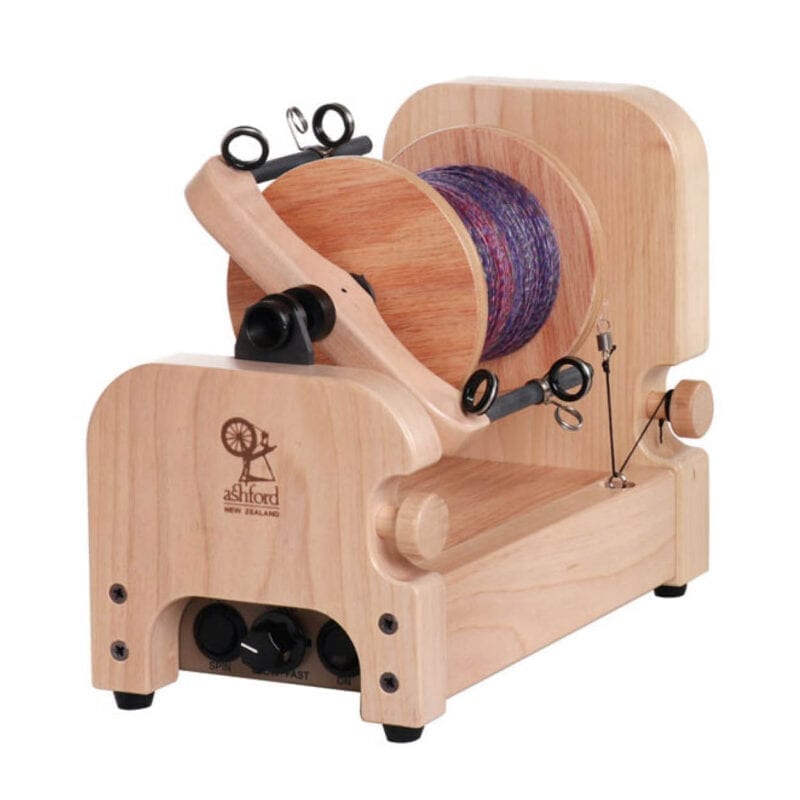
- Regularly apply a drop of oil to the front flyer bearing and bobbin bearings.
- If the flyer vibrates at high speed move the yarn guides so they are opposite each other.
- If the red light is flashing short on/long off, this indicates the 12v power pack is under load. Reduce the tension on the brake band. Preferably the springs should just start to stretch but never more than their own length.
- If the motor is hot after extended use, reduce the tension on the brake band. Ideally the springs should just start to stretch but never more than their own length.
- If the brake band wears out replace it and reduce the brake band tension. Preferably the springs should just start to stretch but never more than their own length.
- Check that the groove in the bobbin whorl is smooth and “U” shaped. If worn, rough or has a build up of lacquer, sand it smooth with fine sandpaper.
e-Spinner Super Jumbo
- When not in use, release the tension on the stretchy drive belt by moving it to the smaller bobbin whorl.
- If the flyer doesn’t spin freely, loosen the leather brake tension knob completely and remove the leather brake from the flyer. Apply a drop of oil to the front and back bearings and give the flyer a spin.
- To give an even yarn take up, apply a drop of oil to the flyer shaft and replace the leather brake. Only increase the leather brake tension if the yarn doesn’t pull in.
- If the red light is flashing short on/long off, this indicates the 12v power pack is under load. Reduce the tension on the leather brake.
- If the motor is hot after extended use reduce the tension on the leather brake.
Ashford Traditional spinning wheel maintenance
Traditional Spinning Wheels
- Check the flyer bearings are at right angles to the flyer shaft. If not, loosen the screws holding the maid uprights to the maiden bar, align the bearings and retighten the screws.
- Check that there are large washers between the screw heads and maiden bar.
- Check the alignment of the wheel and flyer whorl. If necessary, loosen the screws holding the adjusting board to the side rails, align the wheel with the whorl (whorls) and retighten.
- Turn the drive belt adjusting knob until the flyer is closest to the wheel. Re-tie or replace the drive band with a soft cotton cord or Turbo Kit. Turn the drive belt adjusting knob until there is sufficient tension to turn the flyer. Do not over tighten as this adds unnecessary friction to the flyer bearings.
- If the wheel is tight between the wheel supports, loosen the bolts (or screws) holding the frame until it is free. Then spin the wheel and gradually retighten the bolts or screws.
Early Traditional Spinning Wheels
- If your wheel has nylon bearings, prise the wheel supports apart and let the oil drop onto the crank between the hub and the bearings.
- On very old Traditional spinning wheels, the con rod was secured to the crank with a bolt and nuts either side of the crank which could loosen and jam against the con rod. If this has happened use a spanner to loosen the two ¼” nuts. Adjust the nuts until the con rod bearing has approx. 1mm (1/16”) clearance, retighten and apply a drop of oil.
- If you Traditional is pre 1975 and has a clunk, most likely the hole for the hub pin in the crank has worn. To overcome this fit a Double Treadle Kit which includes a new crank, hub pin and con rods.
- If a new bobbin has been fitted to a very old flyer and the small bobbin end rubs against the flyer, use a wood file or sandpaper or to remove wood where the bobbin touches the flyer.
Ashford Traveller spinning wheel maintenance
- Check the flyer bearings are at right angles to the flyer shaft. If not, loosen the screws holding the maid uprights to the maiden bar, realign the bearings and retighten the screws.
- Check that there are large washers between the screw heads and maiden bar.
- Check the alignment of the wheel and flyer whorl. If necessary, loosen the screws in the hinges holding the maiden bar to the top rail, align the wheel with the whorl (whorls) and retighten.
- If the flyer vibrates, tighten the bolts and screws securing the uprights to the base, top rail, maiden bar and maid uprights.
- Turn the drive belt adjusting knob until the flyer is closest to the wheel. Locate the drive band in the flyer whorl you are going to use and re-tie or replace the drive band with a soft cotton cord or Turbo Kit. Turn the drive belt adjusting knob until there is sufficient tension to turn the flyer and prevent it vibrating.
What to do when the legs on your traveller spinning wheel are loose
- If the legs are loose in the base, you can permanently glue them in. Remove the 4 screws and legs. Wax the steel ends of the treadle rail, apply wood glue to the front legs and the front holes in the base. Insert the treadle rail into the holes in the legs. Check the treadle rail is at the front of the spinning wheel, insert the legs back into the base and tap home firmly. Check the treadle turns freely. Repeat this process for the back legs. Check it doesn’t rock on a flat surface. Then secure the 4 legs with screws
- If the Traveller rocks on its legs, place it on a flat surface and identify which pair of legs are longer. Check to make sure these legs have been fully tapped into the holes in the base. Then, if necessary, place a piece of sandpaper under one of the longer legs and rub the back and forth. Repeat for the other leg until level.
- The gap between the wheel bearings and hub should be 0 – 1mm (0- 1/16”). This can be altered by loosening the 2 bolts holding the wheel supports and twisting or moving them in or out. Once correct, gradually retighten the bolts while checking the wheel continues to spin freely.
Ashford Elizabeth spinning wheel maintenance
- Check the flyer bearings are at right angles to the flyer shaft. If not, loosen the screws holding the maid uprights to the maiden bar, realign the bearings and retighten the screws.
- Check that there are small washers between the screw heads and maiden bar.
- Check the alignment of the wheel, flyer, and bobbin whorls. If necessary, loosen the knob on top of the maiden bar and move the maiden bar horizontally. Then retighten.
- Loosen the clamp knob and turn the drive belt tensioner until the flyer is closest to the wheel. Re-tie or replace the drive band with a soft cotton cord. Turn the drive belt tensioner until there is sufficient belt tension to turn the flyer. Do not over tighten as this adds unnecessary friction to the flyer bearings.
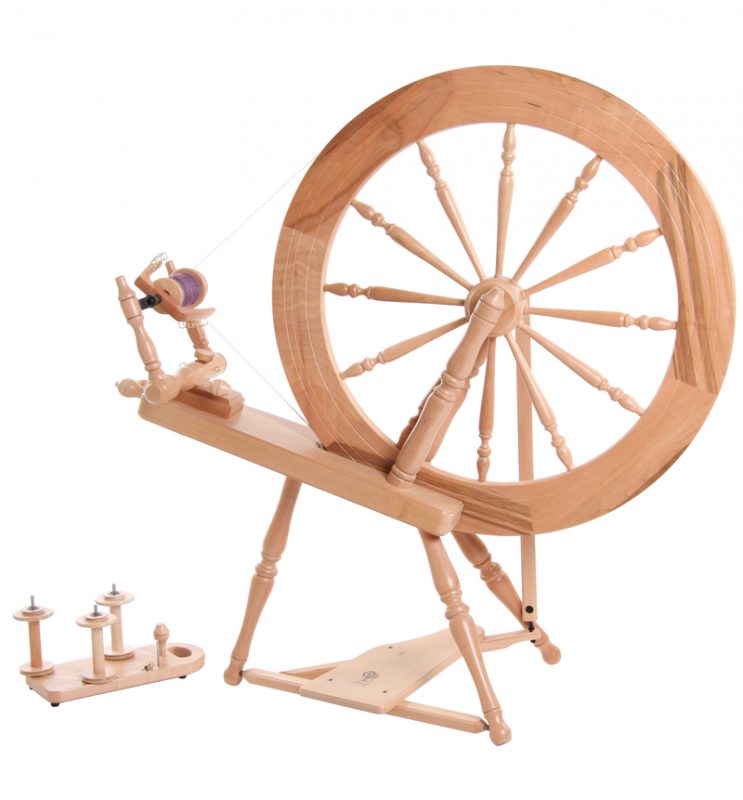
What to do if the legs of your Elizabeth spinning wheel are loose
- If the legs are loose in the base, you can permanently glue them in. Remove the 3 screws and legs. Wax the steel ends of the treadle rail, apply wood glue to the short front and long back legs and corresponding holes in the base. Insert the treadle rail into the holes in the legs. Check the treadle rail is at the front of the spinning wheel, insert the legs back into the base and tap home firmly. Check the treadle turns freely. Then secure with screws. Repeat this process for the short back leg.
Early Elizabeth Spinning Wheels
- To alter the alignment on pre 2004 Elizabeth Spinning Wheels, loosen the bolts securing the wheel supports to the base, twist both supports until the wheel and whorls align, check the wheel spins freely and gradually retighten the bolts checking the wheel continue to spin freely.
Ashford Joy spinning wheel maintenance
- When not in use, release the tension on the stretchy drive belt by moving it to a smaller flyer whorl.
- Always carry your Joy by the built-in handle. However, if the flyer shaft does get bent and wobbles, it is possible to straighten it. Thread the flyer firmly into the top shaft. Next, rotate the flyer very slowly, identify when the orifice is at the top and mark the highest point. Gently press down on the flyer orifice. Then rotate to check if there is any improvement. Repeat this process until the wobble has been eliminated.
- If the flyer doesn’t spin freely the e-Clips on the top shaft may be tight against the ball bearings. Remove the rear e-Clip. If the flyer now spins freely press both ball bearings further into the bearing housings until the groove in the top shaft is visible. If tight it may be necessary to use 2 small G-clamps, a block of wood and a 7/8” x 3/8” steel washer. Then snap the e-Clip back into the groove in the top shaft.
- If the front section of a double treadle crank rubs on the back con rod it indicates the crank has been bent in. Remove the front con rod and use a 250mm (10”) or larger adjustable spanner to gently pull the crank forward until there is 5mm (1/4”) clearance. Then replace the front con rod.
- To protect you Joy when not in use, store it in a carry bag.
Early Joy Spinning Wheels
- If your Joy was made before 2012 it will have steel hinges under the treadle board. Next, lay the Joy it on its back and apply a drop of oil to each hinge pin. Since 2012 Ashford have used polyurethane hinges which do not need lubrication.
Ashford Kiwi spinning wheel maintenance
- When not in use, release the tension on the stretchy drive belt by moving it to a smaller flyer whorl.
- If the flyer doesn’t spin freely and there isn’t any side float between the flyer and the front and rear bearings, the rear bearing may not be fully inserted into the wooden upright. Next, remove the rear upright, lay it on a flat surface and gently tap the bearing until it stops. Finally, reassemble.
Early Kiwi Spinning Wheels
- If your Kiwi was made before 2012, lay it on its back and apply a drop of oil to each hinge pins. Since 2012 Ashford have used polyurethane hinges which do not need lubrication.
-
Diz Stick and Yarn Gauge$26.50 inc GST
-
Traveller 3 Spinning Wheel$860.00 – $1,000.00 inc GST
-
E-Spinner Kit$1,089.00 inc GST
-
Kiwi Spinning Wheel Kit$920.00 inc GST
-
Traditional Spinning Wheel Kit$1,135.00 inc GST
-
Ball Winder – Natural$159.95 inc GST
-
Kiwi 3 Spinning Wheel Carry Bag$185.00 inc GST
-
Introduction to Spinning Kit$89.90 inc GST
-
Signature Ball Winder$235.00 inc GST

